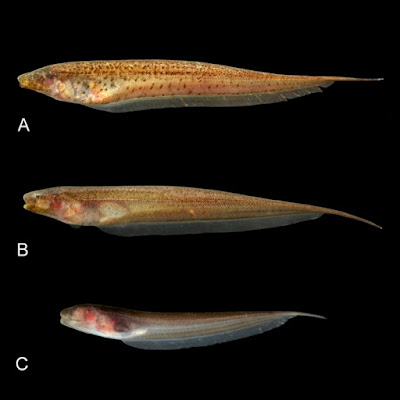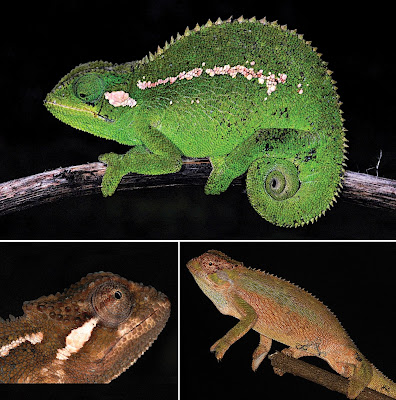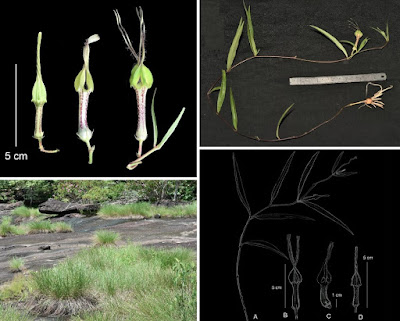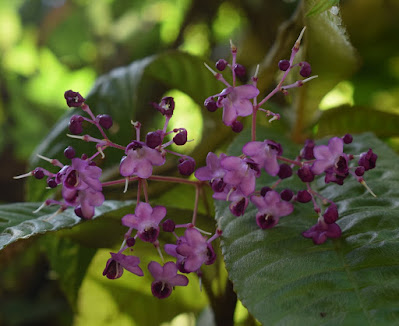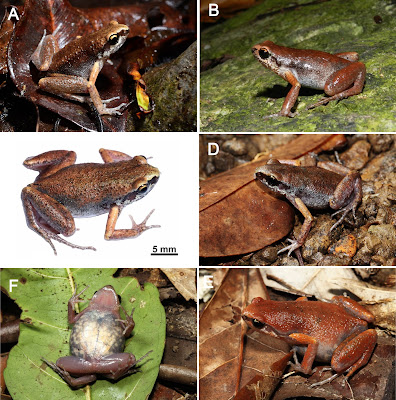[Most Recent Entries] [Calendar View]
Saturday, March 13th, 2021
| Time | Event | ||||||
| 8:34a | [Ichthyology • 2021] Brachyhypopomus degy • A New Species of Amazonian Bluntnose Knifefish Brachyhypopomus (Gymnotiformes: Hypopomidae), with Comments on Its Phylogenetic Position
Abstract A new species of the bluntnose knifefish genus Brachyhypopomus Mago-Leccia is described from headwaters of upper Rio Juruena, and upper Rio Machado, Amazon basin, Brazil. The new species differs from all congeners by the absence of a small independent ossification of the Weberian complex located posterodorsally to the supraoccipital. It can be additionally distinguished from its congeners by a set of characters in combination that includes: absence of accessory electric organ over the opercular region, absence of a prominent pale uninterrupted middorsal stripe on body, presence of scales on the entire middorsal region of body, dorsal rami of the recurrent branch of anterior lateral-line nerve not externally visible, presence of a dark suborbital stripe, and possession of 8–10 scale rows above the lateral line. The phylogenetic position of the new species is inferred by its inclusion in a total-evidence matrix with data from morphology, mitochondrial genes, and nuclear genes of all species. The new species is apparently restricted to upland tributaries of the Chapada dos Parecis, more than 500 m high. Comments on the occurrence of fish species in multiple independent basins at Chapada dos Parecis are also provided. Key words: Bayesian inference, biodiversity, electric fishes, maximum parsimony, neotropical fauna, taxonomy Guilherme Moreira Dutra, Luiz Antônio Wanderley Peixoto, Luz Eneida Ochoa, Willian Massaharu Ohara, Carlos David de Santana, Naércio Aquino Menezes and Aléssio Datovo. 2021. A New Species of Amazonian Bluntnose Knifefish Brachyhypopomus (Gymnotiformes: Hypopomidae), with Comments on Its Phylogenetic Position. Systematics and Biodiversity. DOI: 10.1080/14772000.2021.1877844 | ||||||
| 8:40a | [Herpetology • 2021] Trioceros wolfgangboehmei • A New Chameleon of the Trioceros affinis Species Complex (Squamata, Chamaeleonidae) from Bale Mountains, Ethiopia
Abstract A new species of chameleon, Trioceros wolfgangboehmei sp. nov., inhabiting the northern slopes of the Bale Mountains in Ethiopia, is described. It differs from its Ethiopian congeners by a combination of the following features: presence of a prominent dorsal crest with a low number of enlarged conical scales reaching along the anterior half of the tail as a prominent tail crest, a casque raised above the dorsal crest, heterogeneous body scalation, long canthus parietalis, rugose head scalation, high number of flank scales at midbody and unique hemipenial morphology. Based on morphological characteristics, phylogenetic discordances of previous studies and biogeographical patterns, this new species is assigned to the Trioceros affinis (Rüppell, 1845) species complex. An updated comprehensive key to the Trioceros found in Ethiopia is provided. Key Words: Bale Mountains, biogeography, Ethiopia, Great Rift Valley, key, morphology, new species, systematics, taxonomy, Trioceros wolfgangboehmei sp. nov. Trioceros wolfgangboehmei, sp. nov. Suggested common English name: Wolfgang Böhme’s Ethiopian Chameleon Diagnosis: Trioceros wolfgangboehmei sp. nov. is a small-sized chameleon of the Trioceros affinis species complex (sensu Ceccarelli et al. 2014). It can be distinguished from all other members of the same species complex by the following combination of characters: (1) presence of a prominent and well-developed dorsal crest consisting of a relatively low number of significantly pointed and enlarged conical scales, forming a single row and reaching along the anterior half the tail; (2) top of the casque posteriorly raised above the dorsal crest; (3) heterogeneous body scalation with both small scattered standard scales and enlarged flattened plate-like scales; (4) long canthus parietalis formed by 9–12 slightly enlarged scales; (5) rugose head scalation consisting of enlarged scales forming the cranial crests that fill the area between the lateral and temporal crest and the posterior rim of the orbit; (6) relatively high number of flank scales at midbody (53–59); (7) relatively short snout-vent length (up to 66 mm); (8) a unique hemipenial morphology including shallow calyces with smooth margins on the truncus, four pairs of thick, pointed and thorn-like papillae and two pairs of non-serrated rotulae. Etymology: The specific epithet honours Wolfgang Böhme, senior herpetologist at the Zoological Research Museum Alexander Koenig in Bonn, Germany, for his numerous contributions to research on chameleons, for his outstanding and ongoing herpetological research in general, and, last but not least, for his continuously generous support of the first as well as second author and numerous junior zoologists. The species epithet is a noun in the genitive case.
Thore Koppetsch, Petr Nečas and Benjamin Wipfler. 2021. A New Chameleon of the Trioceros affinis Species Complex (Squamata, Chamaeleonidae) from Ethiopia. Zoosystematics and Evolution. 97(1): 161-179. DOI: 10.3897/zse.97.57297 | ||||||
| 9:01a | [Botany • 2021] Ceropegia longicaudata (Apocynaceae, Asclepiadoideae) • Taxonomic Study of Ceropegia L. for The Flora of Laos: One New Species and One New Record from central Laos
Abstract A newly discovered species from central Laos, Ceropegia longicaudata, is here described and illustrated. It is compared with the morphologically similar species Ceropegia cochleata Kidyoo. Ceropegia longicaudata displays clear differences in the leaf pubescence and venation, length of the corolla lobe tips, colour of corolla lobe, and shape of staminal corona lobes. Ceropegia cochleata is newly recorded for the Flora of Laos. A key to the now three species of Ceropegia in Laos is also provided. Keyword: Ceropegia cochleata, Ceropegia laotica, Ceropegieae, Khammouan, new species, Phoukhaokhouay National Protected Area Ceropegia longicaudata Phonep. & Rodda, sp. nov. Diagnosis. Ceropegia longicaudata is similar to C. cochleata in having tuberous rootstock and linear lanceolate laminas. It can be separated by glabrous leaves without distinct nerves (vs. pubescent with distinct nerves in C. cochleata), longer corolla lobe tips (25–30 mm in C. longicaudata vs. 15–20 mm in C. cochleata), colour of corolla lobe completely bright green (vs. basally green with reddish brown apex), and staminal corona lobes distally with recurved diverging apices (vs. straight and converging). Etymology. The specific epithet ‘longicaudata’ refers to long corolla lobes that characterize this species. Distribution. Only known from Phoukhaokhouay National Protected Area, in Laos. It is found at two locations, the type locality in Vientiane Province (Fig, 5), and from a locality 25–30 km eastwards, in Bolikhamxay Province, where it was photographed by Bertrand Laville in 2016 (theceropegiablog.wordpress.com/2016/02/22/anew-locality-f Ecology and habitat. This species rooted in very thin soils over large sandstone boulders growing together with grasses. The plants were climbing over grasses in open areas partially exposed, at 270–300 m a.s.l. Flowering August–September. Vernacular name. ດອກຈິນດາພູເຂົາຄວາຍ ‘Dok Chinda Phoukhaokhouay’ [Phoukhaokhouay jewelry flower] (proposed here). Phongphayboun Phonepaseth and Michele Rodda. 2021. Taxonomic Study of Ceropegia L. (Apocynaceae, Asclepiadoideae) for The Flora of Laos: One New Species and One New Record from central Laos. Taiwania. 66(1); 93-100. | ||||||
| 9:19a | [Botany • 2020] Boeica arunachalensis (Gesneriaceae) • A New Species from Indian Eastern Himalaya and Typification of Five Names in Boeica
Abstract Boeica arunachalensis, a species new to the science from eastern Himalayan state of India, Arunachal Pradesh is described. Coloured photo plate and micrograph of new species and its allied species B. fulva Clarke are provided. Identity of B. griffithii Clarke is discussed and lectotype are designated here for B. filiformis Clarke, B. fulva Clarke, B. griffithii Clarke, B. hirsuta Clarke and B. porosa Clarke. Etymology: The specific epithet refers to the state of Arunachal Pradesh, from where the species was discovered. Dipankar Borah, Rajeev Kumar Singh, Momang Taram and A. P. Das. 2020. Boeica arunachalensis (Gesneriaceae), A New Species from Indian Eastern Himalaya and Typification of Five Names in Boeica. Indian Forester. 146(9); 871-874. DOI: 10.36808/if/2020/v146i9/150712 | ||||||
| 11:27a | [Herpetology • 2021] Micryletta immaculata • A New Species of the Genus Micryletta (Anura, Microhylidae) from Hainan Island, China
We report on a new amphibian species of the genus Micryletta from Hainan Island, China, based on morphological and molecular analyses. The new species, Micryletta immaculata sp. nov., is diagnosed by a combination of the following morphological characters: medium-sized within genus (SVL 23.3–24.8 mm in males, n=3; 27.7–30.1 mm in females, n=2); dorsum bronze brown to reddish brown in life; dark brown spots and stripes on dorsum and flank absent; flanks largely pigmented with silver white; throat in adult males dark brown; undersides without dark patterns; outer metatarsal tubercle absent; supratympanic fold distinct; webbing between toes basal and poorly developed; tibiotarsal articulation adpressed limb reaching level of tympanum. The new species is divergent from all other congeners based on 16S rRNA gene sequences (3.0%–7.7%). Data on the natural history and male advertisement calls of the new species are provided. Following the IUCN Red List Categories and Criteria, we propose the new species to be listed as Vulnerable B1ab (iii).
Micryletta immaculata sp. nov. Chresonymy: Micryletta inornata — Lau & Chan, 2012: 54; Plate 1 (Yinggeling National Nature Reserve, Hainan, China). Etymology: The specific epithet immaculata (meaning “spotless”, “immaculate”) is a Latin singular feminine adjective in the nominative case and refers to the absence of distinct dark spots or stripes on the dorsum and lateral sides of the body in the new species. We propose “Hainan Paddy Frog” for the common English name and “海南小姬蛙” (Hainan Xiao Ji Wa) for the common Chinese name of the new species. Diagnosis: The new species is assigned to the genus Micryletta based on its possession of the following morphological characters, which are considered diagnostic for the genus: body size small; vomerine teeth absent; dorsal skin smooth and scattered with flat and small tubercles; forelimbs thin and slender; tympanum roughly distinct; subarticular tubercles on fingers and toes large and very prominent; supernumerary tubercles on palm present and distinct; three metacarpal tubercles; tips of digits round, not expanded into discs, with no peripheral grooves; distinct dermal ridges present under 3rd to 4th toes (Dubois, 1987; Fei et al., 2009). Micryletta immaculata sp. nov. can be distinguished from its congeners by a combination of the following characters: medium-sized within genus (SVL 23.3–24.8 mm in males, n=3; 27.7–30.1 mm in females, n=2); dorsum bronze brown to reddish brown in life; dark brown spots and stripes on dorsum and flank absent; flanks largely pigmented with silver white; throat in adult males dark brown; undersides without dark patterns; outer metatarsal tubercle absent; supratympanic fold distinct; webbing between toes basal and poorly developed; tibiotarsal articulation adpressed limb reaching level of tympanum.
Jian-Huan Yang and Nikolay A. Poyarkov. 2021. A New Species of the Genus Micryletta (Anura, Microhylidae) from Hainan Island, China. Zoological Research. DOI: 10.24272/j.issn.2095-8137.2020.333 |
| << Previous Day |
2021/03/13 [Calendar] |
Next Day >> |
